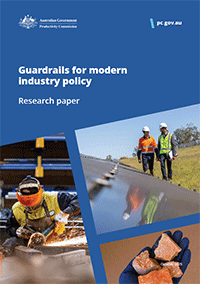Guardrails for modern industry policy

Research paper
Released 21 / 10 / 2025
Industry policy objectives in Australia and internationally have become broader than traditional industry protection. Many interventions now aim to strengthen economic resilience and security, encourage domestic emissions abatement, and position industry to benefit from the transition to a global net zero economy.
However, industry policy interventions require strong guardrails to ensure they deliver value for taxpayers' money. These guardrails should include:
• economic frameworks
• transparent and contestable decision-making processes
• clear methods for measuring performance
• defined plans for ending policies that fail to perform.
This paper sets out a framework to help policy makers determine whether an industry sector does or doesn't warrant support in pursuit of the broader objectives of net zero and economic resilience and security. The framework also helps identify appropriate policy responses in either case.
Download the paper
- Preliminaries: Cover, Copyright and publication detail, Contents, and Acknowledgments
- Summary
- 1 About this research
- 1.1 Understanding modern industry policy
- 1.2 Scope
- 1.3 Organisation of the paper
- 2 Economic resilience and security
- 2.1 A three-step process for considering responses to supply chain risk
- 2.2 Case study: personal protective equipment for healthcare workers
- 2.3 Extending the framework to national security considerations
- 2.4 Iterative risk framework case study: communications hardware
- 3 Net zero transformation
- 3.1 The role of industry policy in the net zero transformation
- 3.2 Applying these principles
- A Policy options for economic resilience and security
- B Identifying vulnerable, essential and critical goods and services
- C Assessing comparative advantage
- Abbreviations
- References
We value your comments about this publication and encourage you to provide feedback.


